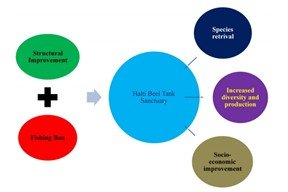Fish sanctuary as a sustainable management tool for recovering fish biodiversity, production and livelihood: A case study on Halti Beel tank sanctuary, Bangladesh
Abstract
Fish sanctuary is a common tool for retrieving fisheries diversity in a threatened aquatic ecosystem. The present study highlighted a case study on sustainable management of Halti Beel tank sanctuary, Bangladesh (a part of Chalan Beel) established for the betterment of fisheries and fishermen community. The study was conducted for a period of 6 months from July to December 2017. Both primary and secondary data was used for a comparison before and after effects of Halti Beel tank sanctuary considering three parameters viz., fisheries diversity, production trends and socio-economic condition of fishermen community. During the study period, diversity in both native and exotic fish species (71) were increased where 62 species were native and 9 were exotic under 26 families of 11 orders. This number (71) was observed 97.22% higher than the number of species before declaring Halti Beel tank as fish sanctuary. Recovery rate was observed highest for the order Siluriformes (11) and the lowest for Channiformes (1). Cypriniformes was the most diversified order with 24 species (18 native and 6 exotic species). The observed data showed a dramatic increase in fish production from 8.77 to 37.50 metric ton within four fiscal years whereas the gradual production trend was recorded 10.12, 29.47, 35.10 and 37.50 metric ton, respectively in the year 2013-2014, 2014-2015, 2014-2015 and 2016-2017. The study was also showed a satisfactory improvement in financial and housing assets as socio-economic status of fishermen community involved in the management of Halti Beel tank sanctuary.
Keywords:
Chalan Beel, Fish diversity, Fish retrieval, Halti Beel, SanctuaryDownloads
References
Ahmed, K. and Ahmed, M. (2002). Fish Sanctuary: Necessity, Concepts, Practices and Prospects, pp.136.
Ali, M.L. and Thompson, P. (2006). MACH (Management of Aquatic Ecosystem through Community Husbandry). Wetland Protection and Enhancement through Sanctuaries in Bangladesh. Technical Paper 4. Dhaka. pp.1-22.
Azher, S.A., Dewan, S., Wahab, M.A. Habib, M.A.B. and Mustafa, M.G. (2007). Impacts of fish sanctuaries on production and biodiversity of fish and prawn in Dopi beel, Joanshahi haor, Kishoregonj. Bangladesh Journal of Fisheries, 30: 23-36.
DoF (Department of Fisheries). (2016). Fish Week Compendium. DoF, Ministry of Fisheries and Livestock, Government of Bangladesh: Dhaka. pp.1-148.
Farid, B.M.S.A.B., Mondal, S., Satu, K.A., Adhikary, R.K. and Saha, D. (2013). Management and socio-economic conditions of fishermen of the Baluhar Baor, Jhenidah, Bangladesh. Journal of Fisheries, 1(1): 30-36.
Flura, M., Alam, M.A., Rahma, M.A., Ahmed, T. and Roy, K.C. (2015). Ecology and water quality parameters of Balla Beel in Moulovibazar district of Bangladesh. Asian Journal of Medical and Biological Research, 1(2): 198-208.
Galib, S.M., Naser, S.M.A., Mohsin, A.B.M., Chaki, N. and Fahad, F.H. (2013). Fish biodiversity of river choto Jauuna, Bangladesh: present status and conservation needs. International Journal of Biodiversity and Conservation, 5(6): 389-395.
Haque, A.S.M., Nahiduzzaman, M., Hossain, M.A.R., Watton, C.C. and McWillian, R. (2012). Impact of fish sanctuaries on rural poor community people in the Ghagot river, Rangpur, 5th Fisheries Conference and Research Fair, Dhaka, Bangladesh. pp.110.
Hasan, M.A.N.G.M., Lucky, N.S. and Hossain, M.A.R. (2012). Natural food abundance and SIS biodiversity of Matshaya Rani Fish Sanctuary. Journal of Environmental Science & Natural Resources, 5(1): 319-328.
Hasan, M.R., Kabir, M.R., Alam, M.M. and Reza, M.A. (2013). Present biodiversity status of freshwater loaches of Bangladesh. Bangladesh Research Publication Journal, 8(3): 203-214.
Joadder, M.A.R., Alam, M.B., Siddique, M.A.B. and Naim, J. (2016). Present status of fish diversity in the Beel Kumari in relation to fish sanctuary and fishing gears. Journal of Fisheries, 4(2): 390-396, http://dx.doi.org/10.17017/jfish.v4i2.2016.172
Kabir, K.M.R., Adhikary, R.K., Hossain, M.B. and Minar, M.H. (2013). Livelihood status of fishermen of the old Brahmaputra River, Bangladesh. World Applied Sciences Journal, 16(6): 869-873.
Khan, M.A.R., Ali, M.M., Salam, M.A., Kunda, M. and Pandit, D. (2018). Impact of fish sanctuary on fish biodiversity and livelihoods of fishermen in Kolavanga Beel of Bangladesh. World Journal of Fish and Marine Sciences, 10(5): 46-54, http://dx.doi.org/10.5829/idosi.wjfms.2018.46.54
Kostori, M.F. (2012). Socio-economic condition of fishermen of the Chalan Beel under Tarash thana of Sirajganj District in Bangladesh. Bangladesh Research Publication Journal, 6(4): 393-402.
Mustafa, M.G. and Ilyas, M. (2012). Community based fish sanctuaries: improving fish biodiversity and protects inland fisheries of Bangladesh. pp 115-128. In: Wahab, M.A., Shah, M.S., Hossain, M.A.R., Barman, B.K. and Hoq, M.E. (eds.), Advances in Fisheries Research in Bangladesh: I. Proc. of 5th Fisheries Conference & Research Fair 2012. 18-19 January 2012, Bangladesh Agricultural Research Council, Dhaka, Bangladesh Fisheries Research Forum, Dhaka, Bangladesh. pp.246.
Paul, B., Faruque, H. and Ahsan, D.A. (2013). Livelihood status of the fishermen of the Turag River, Bangladesh. Middle-East Journal of Scientific Research, 18 (5): 578-583, http://dx.doi.org/10.5829/idosi.mejsr.2013.18.5.81139
Rahman, A., Alam, M., Mainuddin, K., Ali, L., Alauddin, S.M., Rabbani, M.G., Miah, M.M.U, Rabiuzzaman, M. and Amin, S.M.A. (2009). The probable impacts of climate change on poverty and economic growth and the options of coping with adverse effect of climate change in Bangladesh. Support to monitoring PRS and MDGs in Bangladesh, Planning Commission, Government of the People’s Republic of Bangladesh & UNDP Bangladesh.
Rahman, A.K.A. (2005). Freshwater fishes of Bangladesh (2nd ed.). Zoological Society of Bangladesh, Department of Zoology, University of Dhaka, Dhaka-1000.
Rahman, M.B., Hoque, M.S., Mukit, S.S., Azam, M. and Mondal, M. (2016). Gears specific Catch Per Unit Effort (CPUE) with special reference to declining causes of ichthyofauna in the Kajal River of Southern Bangladesh. International Journal of Fisheries and Aquatic Studies, 4(2): 382-387.
Talwar, P.K. and Jingran, A.G. (1991). Inland Fishes of India and Adjacent Countries. Oxford and IBH Publishing Company, Volume No. 2, New Delhi. pp.936-1023.
Nelson, J.S., 2006. Fishes of the World, 4th Edition. New Jersey: John Wiley & Sons Inc.

Published
How to Cite
Issue
Section
Copyright (c) 2020 Agriculture and Environmental Science Academy

This work is licensed under a Creative Commons Attribution-NonCommercial 4.0 International License.

